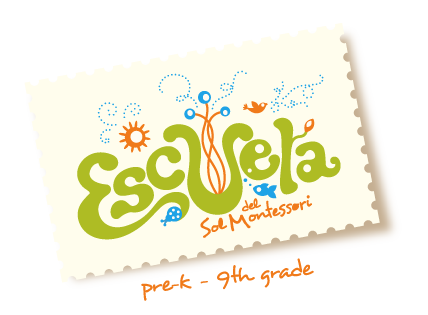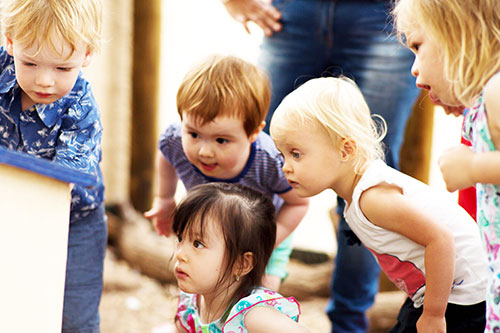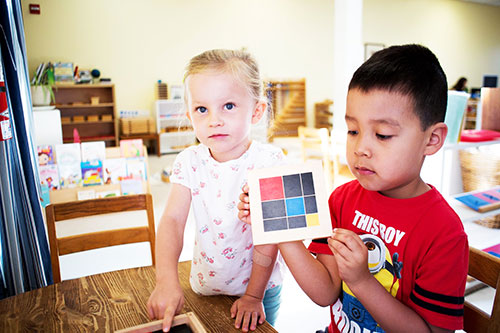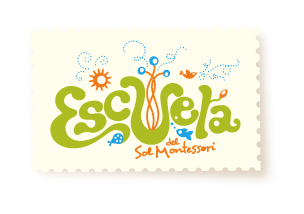People of all ages find ways to care for others – it’s a huge part of what has allowed us to survive and thrive as a species! Activities related to Care of Others provide a great sense of joy, accomplishment, and contribution. It feels wonderful to help others, and as children grow they develop skills that allow them to make more and different contributions to their family and community. This important work also supports neurological development that lays a foundation for empathy and executive functions such as impulse control and emotional regulation. It builds the knowledge that caring for others throughout your life is valuable and important work.
Being part of a community is a large part of the learning done in a Montessori classroom. Guides in all levels model “Grace & Courtesy.” Grace and Courtesy are culturally relevant lessons about how to be part of a community. This may include how to observe someone working, how to invite someone to have snack with you, how to interrupt or ask for help, how to sneeze into your elbow, and so much more. Respect is an intrinsic part of the Montessori classroom. Across the continuum, Classroom Guides and students build relationships based on mutual respect, trust, and care.
At the Early Childhood level, caring for others is about learning to share space and resources. Montessori materials, including writing utensils and art supplies, are a shared part of the prepared environment. Early Childhood students also practice relationship and community building by helping a friend to tie their shoes or inviting someone to play with you. Practical Life work may include slicing bananas and offering them to classmates. Preparing and offering food is a practice that winds through the continuum in increasingly sophisticated ways all the way through Jr. High, where students plan, shop for and prepare meals for their classmates, teachers and classroom guests. In Jr. Elementary, Practical Life activities are predominantly related to Care of Others. Elementary children are socially oriented; their world is rapidly expanding. They delight in responsibilities such as welcoming and orienting new students into the classroom, planning and leading PE activities for the class, offering solutions to community problems, and being an active ally – learning how to step in to help when you see someone isn’t being treated with respect.
Problem solving and brainstorming solutions to problems/issues starts in Primary – it is a framework for allowing children to come up with “rules” or guidelines for behaviors. Primary Guides introduce Community Meetings. In Circle, students practice being part of a community by calling each other by our chosen names, sharing news, and taking note of who is missing and offering well wishes in their absence. In Elementary, Community Meeting becomes a time to come together to address the needs of the community. Students work together to find solutions to issues that arise in the community. In Jr. El you’ll hear discussion related to supplies (All the green colored pencils have disappeared!), classroom procedures (Lunch clean up is taking too long!), and interpersonal skills (People aren’t following the rules!). Community Meetings may also provide time to share a project with classmates, learn a new song, or do some role playing.
Senior El and Jr. High students spend much of their pre-adolescent and adolescent years exploring morality and ethics, interpersonal dynamics, and conflict resolution. Because Senior El is a practice society, it becomes a laboratory for building communication skills by having conversations in the moment. Sometimes this means asking for a “do-over” as glorious interpersonal relationship mistakes are made. Students in the second plane of development have an increased sensitivity to “right and wrong”, and Guides support their drive for justice and dignity seeking by having LOTS of discussions about fairness and equity.
Jr. High is a “family style” community. Since there are fewer students in the Jr. High House than in a traditional Senior El class, students learn that they can’t run away from difficulty, but instead learn to appreciate one another; to build a capacity for discourse and courageous conversations across differences. There are many ways adolescents learn to care for others, most notably through collaborative study and work projects, meal preparation, cooking and eating together, planning treks and events, and through weekly Community Meetings. For adolescents, learning to care for others can be challenging since they believe in an “imaginary audience” that is constantly watching and judging them. Early adolescents need many opportunities to practice caring for others within the context of social organization and through social interaction. Most work is done in collaboration or in a group to give them opportunities to talk, which is a favorite thing for adolescents to do! Although it can be difficult for adolescents to care for others in their immediate circles, they do have an unending amount of compassion for those needing love, care, and equity out in the world! The key is to give them opportunities to discuss how caring for others shows up in many areas of their lives, both globally, locally and immediately. By living in their community, they begin to understand that small acts add up and, through mutual aid communities, thrive.
Things to Do at home:
Helping others with just about any household task
Folding laundry
Setting the table before meal
Creating a beautiful centerpiece for the table
Sitting and having a conversation at the end of the day
Taking the dog for a walk






